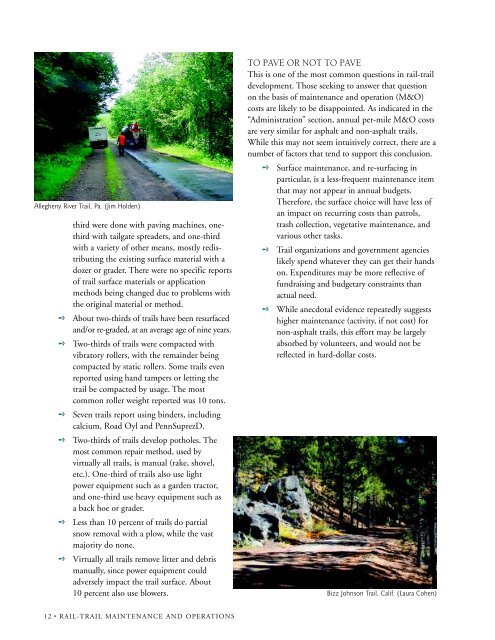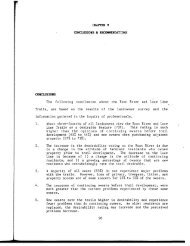Trail Maintenance and Operation - Rails-to-Trails Conservancy
Trail Maintenance and Operation - Rails-to-Trails Conservancy
Trail Maintenance and Operation - Rails-to-Trails Conservancy
You also want an ePaper? Increase the reach of your titles
YUMPU automatically turns print PDFs into web optimized ePapers that Google loves.
Allegheny River <strong>Trail</strong>, Pa. (Jim Holden)<br />
➺<br />
➺<br />
➺<br />
➺<br />
➺<br />
➺<br />
third were done with paving machines, onethird<br />
with tailgate spreaders, <strong>and</strong> one-third<br />
with a variety of other means, mostly redistributing<br />
the existing surface material with a<br />
dozer or grader. There were no specific reports<br />
of trail surface materials or application<br />
methods being changed due <strong>to</strong> problems with<br />
the original material or method.<br />
About two-thirds of trails have been resurfaced<br />
<strong>and</strong>/or re-graded, at an average age of nine years.<br />
Two-thirds of trails were compacted with<br />
vibra<strong>to</strong>ry rollers, with the remainder being<br />
compacted by static rollers. Some trails even<br />
reported using h<strong>and</strong> tampers or letting the<br />
trail be compacted by usage. The most<br />
common roller weight reported was 10 <strong>to</strong>ns.<br />
Seven trails report using binders, including<br />
calcium, Road Oyl <strong>and</strong> PennSuprezD.<br />
Two-thirds of trails develop potholes. The<br />
most common repair method, used by<br />
virtually all trails, is manual (rake, shovel,<br />
etc.). One-third of trails also use light<br />
power equipment such as a garden trac<strong>to</strong>r,<br />
<strong>and</strong> one-third use heavy equipment such as<br />
a back hoe or grader.<br />
Less than 10 percent of trails do partial<br />
snow removal with a plow, while the vast<br />
majority do none.<br />
Virtually all trails remove litter <strong>and</strong> debris<br />
manually, since power equipment could<br />
adversely impact the trail surface. About<br />
10 percent also use blowers.<br />
TO PAVE OR NOT TO PAVE<br />
This is one of the most common questions in rail-trail<br />
development. Those seeking <strong>to</strong> answer that question<br />
on the basis of maintenance <strong>and</strong> operation (M&O)<br />
costs are likely <strong>to</strong> be disappointed. As indicated in the<br />
“Administration” section, annual per-mile M&O costs<br />
are very similar for asphalt <strong>and</strong> non-asphalt trails.<br />
While this may not seem intuitively correct, there are a<br />
number of fac<strong>to</strong>rs that tend <strong>to</strong> support this conclusion.<br />
➺<br />
➺<br />
➺<br />
Surface maintenance, <strong>and</strong> re-surfacing in<br />
particular, is a less-frequent maintenance item<br />
that may not appear in annual budgets.<br />
Therefore, the surface choice will have less of<br />
an impact on recurring costs than patrols,<br />
trash collection, vegetative maintenance, <strong>and</strong><br />
various other tasks.<br />
<strong>Trail</strong> organizations <strong>and</strong> government agencies<br />
likely spend whatever they can get their h<strong>and</strong>s<br />
on. Expenditures may be more reflective of<br />
fundraising <strong>and</strong> budgetary constraints than<br />
actual need.<br />
While anecdotal evidence repeatedly suggests<br />
higher maintenance (activity, if not cost) for<br />
non-asphalt trails, this effort may be largely<br />
absorbed by volunteers, <strong>and</strong> would not be<br />
reflected in hard-dollar costs.<br />
Bizz Johnson <strong>Trail</strong>, Calif. (Laura Cohen)<br />
12 • RAIL-TRAIL MAINTENANCE AND OPERATIONS







